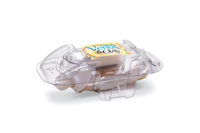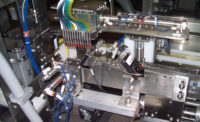Going digital on a flexo press may sound like a contradiction to many people. Weinand van Kesteren, however, has been perfecting his “smart digital flexo” concept for over a year. And he’s convinced it will enable his company, The Netherlands-based VIV, to become a leader in producing high quality flexible packaging in short and very short runs:
VIV, abbreviated for Packaging Industry Veenendaal, is a family-owned business, established in 1953 as a wholesaler in packaging. Over the years, it has always been quick to recognize trends and opportunities. When van Kesteren and his brother Herman joined the company in the 1980s and subsequently took over from their father, they witnessed how polypropylene became very popular as a packaging material very rapidly. That promted VIV to expand into flexo printing.
Establishing A New Future
Last year, the company installed a brand new 10-color Comexi press next to its already existing Comexi presses. But the market has changed over the years – and Weinand van Kesteren changed course with it.
“In 2006, it became clear to me that the market for floral wrapping foils was about to transform dramatically,” he says. “The number of specialized florist shops would be going down and more flowers would be sold through supermarkets. At the same time, we saw a trend that moved away from our colorful foil designs towards a more eco-look. That left us printing just one color or even supplying just plain foil, and making very little margin. On top of that, the financial crisis hit. We really needed to find ways to establish a new future for our business.”
Gaining an Advantage
van Kesteren found flexible packaging for food to be very promising.
“However, entering this market required us to completely overhaul our machine park,” he notes.
Hence, he decided not to follow the dominant trend at the time of investing in 60-cm-wide narrow web flexo presses, but instead had a 120-cm-wide press installed.
“To me, it’s very simple. You cannot print 120-cm wide on a narrow web press, but you can do 60-cm on a 120-cm-wide press,” he explains. “By making clever use of this width, for example by combining different designs onto one web, you can gain an interesting advantage over your competitors.”
After acquiring its first 8-color press in 2008, a 10-color press followed in 2010. The company is now taking things to an entirely new level.
Digital vs. Flexo Printing
“Everybody seems to be talking about digital printing and short runs,” van Kesteren starts. “So, to find out what the hype is all about, we decided to visit Drupa in 2016 and take a good look at what suppliers were up to in flexible packaging.”
They were impressed. But cost still posed an issue.
“If you are like us, doing your own repro and platemaking in house, the break-even point between digital printing and flexo comes down to around only 2,600 meters for a print job,” van Kesteren explains. “Now, our current average for short runs is about 10,000 meters. That is still a huge run length for a modern digital press, running at 20 meters per minute, while we run at 600 meters per minute in flexo. It just does not make sense for us to switch to digital printing.”
Fixed Palette Printing
Still, the Drupa visit did have an impact. Not only did VIV order an additional 10-color flexo press, but van Kesteren also followed up on something that caught his attention at the show.
“I was impressed by the digital concept of a 7-color system,” he says. “And I knew that such a system of fixed-palette printing was being developed by a group of flexo industry suppliers and used in the label industry. So I decided to take this idea and find a way to make it work on our new press.”
He came up with a name for it: smart digital flexo. “Our entire production process is completely digital, right up until the moment the ink is transferred to the substrate,” he says.
Smart Digital Flexo
By using a standard series of seven colors (CMYK plus orange, green and violet), smart digital flexo, or SDF, is able to achieve some 90 percent of all pantone colors. This way, VIV does not need to mix and match any custom colored inks. Next to saving time, costs and materials, this also enables the smart combination of different jobs onto the web.
“In this way, we aim to offer our customers shorter turnaround times at sharper prices,” van Kesteren notes.
Getting SDF to work as planned has been a work in progress for VIV.
“We really have had to find out pretty much everything all by ourselves,” van Kesteren explains. “We have been doing many test runs and a lot of measurements to get all elements exactly right: prepress-settings, temperatures, inks, speed. Aniloxes also play a crucial role in the process: You absolutely need a consistent and precisely predictable ink transfer to get SDF to work properly.”
Apex International’s specially engraved GTT anilox rollers have come into play helping VIV achieve this greater level of control.
New Range of Business Opportunities
VIV has started to put SDF to practice, and results look promising. The most important thing now, says van Kesteren, is convincing more customers of SDF’s capabilities.
In the future, van Kesteren would like to see all of VIV’s presses running only SDF jobs.. “For sure, there will always be people emphasizing the 10 percent of pantone colors still out of reach of this fixed palette,” he says. “We, however, like to focus on the 90 percent we can do – and do a lot more efficiently. We are now able to produce 15 jobs on this one press per day, instead of just five. SDF saves us a huge amount of time in changeovers and setup times. Having this technology in place, and having found the right suppliers and partners to expand our capabilities in this field, even jobs of just 1,000 meters run length will be within our reach. This will open up a whole new range of business opportunities for VIV.”
VIV




